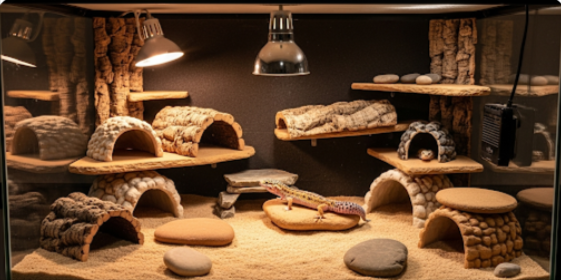Hello friends. To keep your leopard gecko tank setup happy and healthy, a leopard gecko tank setup should be straightforward, safe, and warm. Consider hiding places, heat and a clean environment.
The Importance of Proper Tank Setup

Despite their resilience, leopard geckos are totally dependent on you to provide the ideal habitat. Stress, disease, or even a shorter lifetime for your gecko might result from a badly set-up aquarium. Your gecko may live for 10 to 20 years and occasionally even longer, if the proper conditions are met!
Selecting the Proper Tank
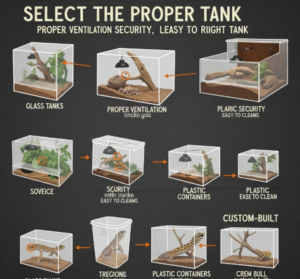
A glass terrarium that is 20 gallons long is the perfect size for one adult leopard gecko. Larger tanks are preferable since they allow for more natural behavior and facilitate the creation of temperature gradients. Because leopard geckos are ground dwellers and prefer floor area over height, steer clear of tall tanks.
Pro tip: You need a screen lid that fits snugly and securely. It keeps your gecko secure while allowing for airflow.
Temperature gradient and heating
Due to their cool blood, leopard geckos rely on outside heat to keep active and digest their food. Your gecko can control its body temperature on its own with the help of a suitable heat gradient.
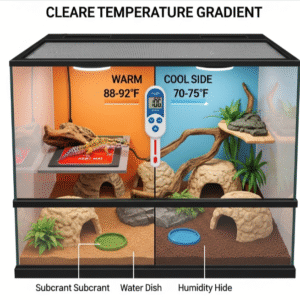
Essentials for heating:
- On one side of the tank, place a heat pad or under-tank heater (UTH).
- Keep the side temperature between 88°F and 92°F (31°C and 33°C).
- The ideal temperature range for the cool side is 75–80°F (24–27°C).
- It is safe for nighttime temperatures to dip to around 70°F (21°C).
Heat rocks can burn the belly of your gecko, so never use them. To monitor the temperature at the surface where your gecko spends time, always use a dependable digital thermometer with a probe.
Lighting Conditions
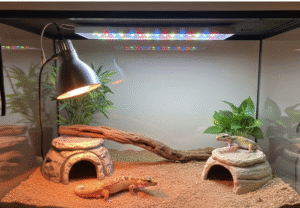
If they consume vitamin D3, leopard geckos do not require specific UVB illumination as some other reptiles do. A low-output UVB lamp (2–5%), on the other hand, can replicate natural circumstances and can be good for their general health. Make sure you maintain a consistent day/night cycle, with around 12 hours of light and 12 hours of darkness.
Substrate: Uses and Avoidances
It’s crucial to select the appropriate substrate (tank flooring). Steer clear of loose surfaces like sand since, in spite of what some pet shops say, ingesting sand can result in fatal impaction.
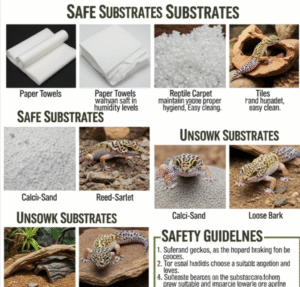
Options for safe substrates:
- Slate tiles are natural nail filer and are easy to clean.
- Reptile carpet is reusable and reasonably priced, but it requires frequent cleaning.
- Paper towels are cheap, simple to replenish, and ideal for quarantine situations or newborns.
Crucial Décor and Hides
At least three hides are required for your leopard gecko:
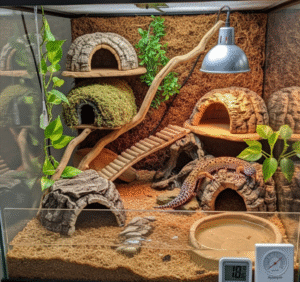
- For security and digestion, warm hide is placed on top of the heat mat.
- For a more comfortable place to relax, place cool hide on the other side.
- Moist hide: lined with paper towels or moist sphagnum moss; aids in shedding.
For enrichment, add branches, pebbles or reptile-safe décor, but make sure they are sturdy to avoid crushing injuries. Natural materials should always be cleaned before being added to the tank.
Providing Humidity and Water

Although they obtain the majority of their moisture from their diet, leopard geckos should always have access to a shallow water dish filled with clean, fresh water. Every day, change it.
The ideal humidity range is between 30% and 40%. While too little humidity might make shedding challenging, too much humidity can lead to respiratory problems.
Essentials of Feeding
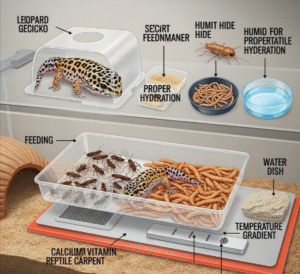
Although the focus of this article is tank setting, the nutrition of your gecko has an impact on how you set up their habitat, particularly with relation to calcium supplements. To prevent metabolic bone disease, dust insects with powdered calcium and vitamin D3. Additionally, keep a little calcium dish in the aquarium.
Upkeep and Cleaning
Your gecko stays healthy when its aquarium is clean. Every day, spot-clean the droppings, and once a month, thoroughly clean the tank:
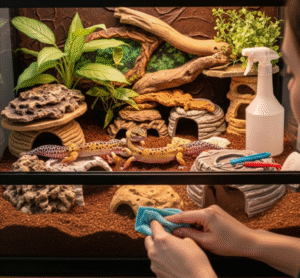
- Take everything out, even your gecko.
- Use a cleaner safe for reptiles to clean the décor and skins.
- Wash or replace the substrate.
- Rinse everything well before replacing it.
Last Words of Advice for Achievement
- Before bringing new geckos close to other geckos, place them in quarantine.
- Before handling, let your gecko a few days to become used to their new surroundings.
- Keep an eye on your gecko every day; their feeding patterns, shedding patterns & droppings may reveal a lot about their health.
In conclusion
Greetings Reader, Although maintaining a leopard gecko tank does not have to be difficult, doing it correctly is essential to your pet’s long-term happiness and health. Keep in mind that safe substrate, secure hides, enough heating or routine cleaning are all crucial.
You can now sit back and enjoy watching your little reptile companion explore, hunt and live its best life since you now know how to make the perfect habitat for your leopard gecko.
Let’s offer every leopard gecko the ideal tank they deserve if you found this information useful. Please share it with other reptile enthusiasts.
FAQ’S:
What is the ideal tank size for a leopard gecko?
An adult leopard gecko should be kept in a tank that is 20 gallons long.
Should I fill my leopard gecko’s tank with sand?
Sand can cause deadly impaction if eaten, therefore stay away from it.
Are heat lights necessary for leopard geckos?
Not always. For belly heat, an under-tank heater (UTH) works best, but a low-output UVB lamp can also be useful.
What is the ideal temperature for a leopard gecko tank?
Cool side: 75–80°F (24–27°C); warm side: 88–92°F (31–33°C); and nighttime: about 70°F (21°C).
What is the ideal number of hides for a leopard gecko?
Three at the very least: cold hide, warm hide, and a wet hide for shedding.

